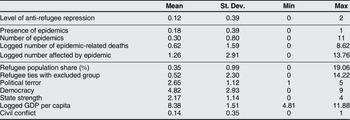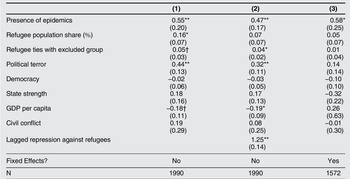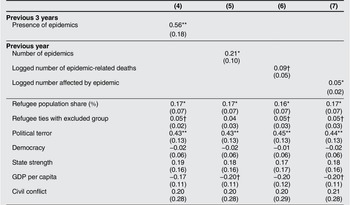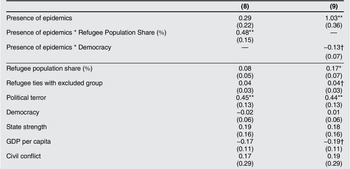The COVID-19 pandemic has placed increasing pressure on governments to take measures to reduce the spread of the virus. As the number of deaths along with the economic and social costs of the pandemic accumulate, governments’ handling of the crisis is placed under a spotlight. Governments typically have three options for responding to aggrieved publics: They can do nothing, use policy levers to address emerging pressures and grievances, or they can deploy tools of repression.Footnote 1 As they find themselves the target of public concerns and criticisms, the option of doing nothing appears to be off of the table for most governments; it is simply too risky, because it likely threatens political survival. The option of addressing the concerns by initiating large-scale public policies would likely be more popular among the public, but the scale of the crisis may make this kind of response too costly or difficult to implement in a timely fashion.
As such, the employment of repressive tactics may be an attractive policy tool for governments to respond to crises promptly (Wood and Wright Reference Wood and Wright2016).Footnote 2 However, indiscriminate repression, i.e., broad targeting of the general public, is likely to be unpopular and counterproductive for the goal of political survival (Kydd and Walter Reference Kydd and Walter2006, Carlson and Listhaug Reference Carlson and Listhaug2007). Rather, governments have incentives to strategically choose who to target to avoid paying broader electoral costs of repression (Bueno de Mesquita et al. Reference de Mesquita, Bruce, Siverson and Morrow2003, Klein and Tokdemir Reference Klein and Tokdemir2019). There are strong incentives, therefore, for leaders to deflect criticism by targeting out-groups. In particular, refugee populations can be strategically attractive targets, because they typically hold little political power with which to punish culpable leaders (Savun and Gineste Reference Savun and Gineste2019).
Sure enough, there appears to be a number of examples of governments targeting refugee populations during the ongoing COVID-19 crisis. Right-leaning political leaders throughout the world have called for tougher actions to limit the mobility of migrants and refugees to counter the threat of the COVID-19 pandemic, suggesting that these vulnerable populations pose a risk as vectors of the disease.Footnote 3 In Hungary, for example, Prime Minister Viktor Orbán stated that migrants and the disease are connected because both “spread with movement.”Footnote 4 Similar logics have been expressed in Croatia, Greece, Italy, and the United States. In each instance, migrant and refugee populations are blamed for the (potential) arrival of the virus on local shores.Footnote 5 Some governments have gone beyond scapegoating refugees for the spread of the COVID-19 and resorted to violation of their rights within their borders. For example, Malaysian authorities arrested over 2,000 Rohingya refugees and put them in detention centers.Footnote 6 Similarly, in Lebanon, twenty-one municipalities introduced severe restrictions on the movement of Syrian refugees (but not Lebanese residents) as part of their efforts to combat the spread of COVID-19.Footnote 7
In this article, we examine whether the outbreak of epidemics is associated with an increase in the violation of physical integrity of refugees by host governments.Footnote 8 To do so, we outline a logic for government targeting of refugees during epidemics. We assume that epidemics place strains on economies and societies, potentially resulting in hardship for broad communities, which in turn leads to debate regarding the attribution of blame for ineffective management of the situation. Public attitudes towards refugee populations, and out-groups in general, are typically negative during economic and security crises (Davis and Silver Reference Davis and Silver2004; Isaksen Reference Isaksen2019; Savun and Gineste Reference Savun and Gineste2019). We expect a similar activation of in-group/out-group dynamics during periods of health crisis.
We also assume that governments prioritize their political survival and take actions in pursuit of this priority (Bueno de Mesquita et al. Reference de Mesquita, Bruce, Siverson and Morrow2003). In response to the emergence of public concerns, governments have incentives to identify scapegoats and target them. Refugee populations are well suited as targets of government repression under these conditions. First, refugees are politically powerless and unable to impose electoral costs on governments.Footnote 9 Second, once in-group/out-group anger is activated, the public is increasingly intolerant and potentially even supportive of government targeting of out-groups (Davis and Silver Reference Davis and Silver2004; Stephan, Ybarra, and Bachman Reference Stephan, Ybarra and Bachman1999). Third, the targeting of refugees during crises can be thought of as opportunistic repression (Grasse et al. Reference Grasse, Matfess and Curtice2020) insofar as it might help governments achieve a pre-existing policy goal of encouraging refugee populations to return home and deter new refugees from attempting to enter the country in the future.
We also contend that while all refugee hosting countries may have some incentive to target repression against refugee populations in line with our general logic, there are likely sources of variation in their actual deployment of repression. Specifically, we develop three conditional logics in this paper. First, we suggest that the targeting of refugees depends, in part, upon the availability of suitable targets within the country. Thus, the likelihood should be conditioned by the relative size of the locally hosted refugee population. Second, we suggest that while health epidemics are often unpredictable, their impacts are influenced by political and institutional factors (Kahn Reference Kahn2005). Third, we suggest that democracies have incentives to provide public goods and, therefore, like more capable states, in general, will be better placed to manage the effects associated with the occurrence of epidemics, leaving more autocratic and less capable states more likely to resort to repression of refugees at such times.
In order to test the hypotheses derived from this logic, we design a series of multivariate statistical tests drawing upon evidence from the recent historical record of epidemics and government targeting of refugees between 1996 and 2015. These analyses do not include data on COVID-19. However, they cover a broad range of epidemics experienced across all regions over a number of decades. Accordingly, we believe that they provide meaningful evidence to bring to bear to better understand the possible course of responses to the COVID-19 pandemic. Our results appear to support the logic of scapegoating and opportunistic repression of refugees in response to epidemics. Specifically, the analyses demonstrate that governments increase their violent targeting of refugee populations when epidemics are experienced locally. Moreover, we demonstrate that this effect is conditioned by the size of the refugee population hosted locally and the level of autocratic governance of the country.
We make two important contributions. First, we bring together literatures on health crises, forced migration, and government repression. We highlight one of the political consequences of epidemics by showing how refugees may be a target of violent repression by governments in their efforts to deflect blame for their poor handling of epidemics and to opportunistically deter refugees from staying in the country. Second, we contribute to understandings of the approaches that governments are willing to follow in order to ensure their political survival. Scapegoating of outgroups is not just rhetorical. Rather, governments seem willing to take the opportunity to use crises such as epidemics to target vulnerable populations of refugees. This reinforces the idea that refugees’ suffering does not end once they leave their countries of origin.
Repression as a Response to Epidemics
As Hafner-Burton, Helfer, and Fariss aptly note, “human rights are often the first causalities of crises” (Reference Hafner-Burton, Helfer and Fariss2011, 673). The literature has long established that repression is a common tool that leaders employ when their survival in office is threatened.Footnote 10 Economic, social, and political shocks to the status quo are common such threats to which leaders might respond with repression. It is argued that this is because shocks to the political equilibrium often generate the potential for dissent (Poe and Tate Reference Poe, Carey and Poe2004; Davenport Reference Davenport2007). Following this general logic, scholars have shown that governments deploy repression in response to shocks resulting from demographic shifts (Nordas and Davenport Reference Nordas and Davenport2013), economic sanctions (Wood Reference Wood2008), civil war in the neighborhood (Danneman and Ritter Reference Danneman and Ritter2014), terrorism (Conrad et al. Reference Conrad, Conrad, Walsh and Piazza2017), increasing refugee inflows (Wright and Moorthy Reference Wright and Moorthy2018), and natural disasters (Wood and Wright Reference Wood and Wright2016).
In the case of natural disasters, as an example, the logic would appear to be as follows. When natural disasters strike, at least two important effects are observed. Natural disasters result in hardship within local populations (Kahn Reference Kahn2005). This sense of hardship can serve to increase grievances within local populations. This can, in turn, result in responsible governments experiencing a decline in their real or perceived level of control over the state, which might threaten the survival of the incumbent in office (Quiroz Flores and Smith Reference Quiroz Flores and Smith2013). Both of these conditions seed potential instability in the country, which often results in governments increasing their reliance upon repression (Wood and Wright Reference Wood and Wright2016).
We argue that epidemics, i.e., widespread occurrence of an infectious disease in a population at a particular time, also represent shocks to the status quo that can challenge governments and even threaten leaders’ political survival. This is because they hold the potential to create or exacerbate grievances in the societies experiencing them. Epidemics can provoke public concerns regarding the potential to be exposed to the pathogen. In the case of the emergence of COVID-19, it soon became clear that not only was the disease spreading, but it also seemed to be “infecting societies with a sense of insecurity, fear and fragmentation” (Erlanger Reference Erlanger2020). This places attention on what governments are doing in response as a means of tackling the emerging threat and securing the well-being of their citizens. Thus, dissent may emerge as epidemics expose government deficiencies and inadequate responses, while also highlighting and exacerbating existing structural inequalities in society.Footnote 11 For example, protests have been observed in Mexico demanding greater government investment in personal protective equipment for healthcare workers and in Iran in response to the detrimental effect of perceived government corruption stalling an adequate response to the crisis (Kishi Reference Kishi2020).
While governments face strong pressure to respond to grievances associated with health crises, their opportunity to engage in repression simultaneously may increase in times of crises. This is mainly due to change in the political environment that dampens the cost of repression for the leaders. One common policy tool that leaders use to increase their flexibility of action during crises is declaration of state of emergency, which provides leaders the leverage to adopt invasive activities infringing on citizens’ civil liberties. For example, during the COVID-19 pandemic, many governments have responded to the pandemic by declaring states of emergency and expanding their central authority (Stasavage Reference Stasavage2020).Footnote 12 Executive power-maximizing strategies of this kind have been observed in many places, including Hungary, the UK, Israel, and elsewhere during this crisis.Footnote 13 This practice tracks closely with the ways that governments of all stripes move into power-maximization model when responding to disaster situations (Bjørnskov and Voigt Reference Bjørnskov and Voigt2020; Wood and Wright Reference Wood and Wright2016).
As part of this power-maximization strategy, we have observed a general increase in repression designed to dampen dissent (Kishi Reference Kishi2020) and a perceptible weakening of global criticism of repressive interventions in the name of quelling a threat to global public health (Grasse, Matfess, and Curtice Reference Grasse, Matfess and Curtice2020). Thus, many states have accelerated the militarization of their policing practices as a response to the pandemic.Footnote 14
Refugees as Targets of Repression during Health Crises
Having established that governments might respond to public health crises by employing repression, it is worth considering why they might target refugees with this repression. Refugees are often subject to the basest instincts of extremist political figures. The leader of Hungary, Victor Orbán, accelerated his consolidation of power in 2020 by linking migrants and the spread of coronavirus in justifying the expulsion of multiple Iranian students from the country. In Italy, right-wing politician Matteo Salvini erroneously blamed refugees and migrant workers for the arrival of COVID-19 in the country in spring 2020. Prominent figures in France, the United States, and Croatia have each also taken the opportunity to point the finger in the direction of resident refugee and migrant populations in accounting for escalating local levels of the virus (Zargar Reference Zargar2020).
Why do domestic leaders scapegoat in this manner and are these claims precursors to violence targeted against refugee populations? We assume that the point of departure in motivating the scapegoating of refugees is the difficulty societies experience in coming to terms with the “sudden and violent visitations of mass epidemics” (Evans Reference Evans1988, 124). The arrival of an epidemic locally depends upon the nature of the actions taken by the state. Government efforts to prevent the arrival of an epidemic, contain it, or mitigate against its spread within the community will be subject to evaluation by observers, including the electorate. This process of observation and evaluation can result in rather divergent interpretations locally of where to attribute blame for the disease’s arrival and spread.
Under uncertainty regarding public responses, governments have incentives to assign blame for emerging crises. Although state of emergency laws may allow leaders a certain degree of latitude in curtailing civil and political liberties, repression targeting general domestic audiences might prove counterproductive (Kydd and Walter Reference Kydd and Walter2006) and actually limit relief efforts in response to the epidemic (Gómez and Harris Reference Gómez and Harris2016). Therefore, governments strategically choose who to target to avoid upsetting the electorate (Bueno de Mesquita et al. Reference de Mesquita, Bruce, Siverson and Morrow2003, Klein and Tokdemir Reference Klein and Tokdemir2019).Footnote 15 Recent research suggests that leaders assign blame for crises by using violence against out-groups in the society to deflect criticism (Tir and Jasinski Reference Tir and Jasinski2008). The refugee population can be considered one type of out-group in host states. In the context of security crises, Savun and Gineste (Reference Savun and Gineste2019) argue that refugees serve as ready-made targets for blame and scapegoating. They find that host states are likely to violate physical integrity rights of refugees in the wake of terrorist attacks.
Underlying these trends in the targeting of refugees are baseline negative attitudes that the public hold towards these vulnerable populations. Prominent research in political psychology, sociology, and political science have widely demonstrated that public intolerance of out-groups increases during the times of crises, leading to a spike in xenophobia and prejudice (Stephan, Ybarra, and Bachman Reference Stephan, Ybarra and Bachman1999; Huddy et al. Reference Huddy, Feldman, Taber and Lahav2005; Kam and Kinder Reference Kam and Kinder2007). Historical cases demonstrate how this dynamic had played out during prior health crises (Dionne and Turkmen Reference Dionne and Turkmen2020). When cholera struck Europe in the nineteenth century it “scored the European social consciousness, exacerbated contemporary tensions, and intensified the impact of current social problems” (McGrew Reference McGrew1965, 3). This focused public wrath on outcast groups who were blamed for the invisible enemy. Similarly, in the United States, in the early twentieth century, recent Jewish immigrants were the targets of repression to combat the threat of tuberculosis and Italian immigrants were blamed for the polio epidemics of 1907 and 1916 (Cohn Reference Cohn2012). More recently, Haitians were blamed for the AIDS epidemic (Paik Reference Paik2006).Footnote 16 In 1991, after a military coup in Haiti, hundreds of Haitian refugees were on boats heading to the United States to seek asylum when the US Coast Guard picked them up, tested them for HIV, and took positive cases and family to refugee camps.Footnote 17 The U.S. Government detained 277 HIV positive and family of HIV positive Haitian refugees in a U.S. naval base in Guantanamo for twenty months.Footnote 18 They were detained in squalid and cramped barracks, restricted from seeing their test results, and denied access to any suitable treatment. More recently, during the SARS outbreak in 2003 initial stigma and animosity was targeted towards refugees as potential vectors of the disease (Person et al. Reference Person, Francisco, Holton, Govert and Liang2004). In the UK for instance, some right-wing politicians and media outlets used the SARS in campaigns against immigration and refugees (Wallis and Nerlich Reference Wallis and Nerlich2005).
Agents of many governments have also been observed seeking to harm refugee populations during the course of the ongoing COVID-19 crisis. Amnesty International has documented numerous cases across sixty countries of law enforcement agencies using the opportunity afforded by the ongoing pandemic to commit human rights abuses under the guise of protecting health.Footnote 19 For example, in Bangladesh in late March 2020, despite having only one confirmed case of COVID-19 in the Cox’s Bazaar District at that time and no confirmed cases among refugees, the government suspended the majority of the relief work in the Rohingya refugee camp and encircled the camp with barbered wire to confine the refugees.Footnote 20 Also in the early stages of the outbreak, official Greek security forces and unidentified armed men intensified their crackdown on the borders between Greece and Turkey, detaining, sexually assaulting, and robbing asylum seekers and migrants before sending them back to Turkey.Footnote 21
Common to each of these cases is the tendency to view newly arriving populations as posing biological risks because they sometimes carried with them novel pathogens (Shah Reference Shah2020). Perhaps most notoriously, from the late fifteenth century, Europeans introduced smallpox and measles viruses (that they had coped with for centuries) into Native American populations (Shah Reference Shah2020). This apparent activation of in-group/out-group biases and xenophobia during health crises is supported by evidence that in areas subject to more pathogens, there are greater levels of ethnocentrism (Fincher and Thornhill Reference Fincher and Thornhill2012) and that people who feel more threatened by infectious diseases express more xenophobic attitudes than do people without such feelings of threat (Dutta and Rao Reference Dutta and Rao2015, Shah Reference Shah2020).
These discriminatory attitudes and repressive behaviors fly in the face of lack of scientific evidence showing refugees and migrants increase the exposure of host countries to infectious diseases.Footnote 22 The virus actually appears to have spread first and foremost through the interconnected societies of the West and the networks of the international community’s most mobile members: tourists and traveling business personnel.Footnote 23 Nonetheless, the intentional scapegoating of vulnerable migrant populations hints at governments attempting to shift blame for the emerging crisis. This is, in too many respects, par for the course for refugee populations. After all, refugees are often accused of serving as vectors for violence and insecurity within host communities (Böhmelt, Bove, and Gleditsch Reference Böhmelt, Bove and Gleditsch2019; Braithwaite et al. Reference Braithwaite, Chu, Curtis and Ghosn2019; Fisk Reference Fisk2018), even though they are more commonly the targets of violence than they are its perpetrators (Onoma Reference Onoma2013; Savun and Gineste Reference Savun and Gineste2019).
Nonetheless, refugees are attractive targets of repression for a number of reasons. They are newly arrived outsiders who can credibly (in the eyes of the public) be blamed for the arrival of a novel infectious disease. That is, emerging pathogens are typically characterized by the lack of medical knowledge, which in turn allows leaders to redistribute blame according to existing patterns of discrimination and othering (Dionne and Turkmen Reference Dionne and Turkmen2020). In addition, refugees also do not have electoral power to punish leaders for falsely blaming them for crises and violating their physical integrity rights (Whitaker and Giersch Reference Whitaker and Giersch2015; Savun and Gineste Reference Savun and Gineste2019). Accordingly, leaders have more leeway to target refugees and need not worry as much about punishment by the electorate for targeting refugees because the public’s feeling of insecurity in the times of crisis increases their prejudice and negative perceptions of out-groups, such as immigrants and refugees (Stephan, Ybarra, and Bachman Reference Stephan, Ybarra and Bachman1999; Huddy et al. Reference Huddy, Feldman, Taber and Lahav2005; Kam and Kinder Reference Kam and Kinder2007).
In addition to electoral incentives and public tolerance of mistreatment of out-groups, governments may have another reason to engage in repression of refugees in times of crises. Approximately 85% of refugees globally are hosted in low-income/developing countries,Footnote 24 with 73% hosted in countries neighboring their country of origin (UNHCR 2019). These hosts often face economic difficulties, perceptions of threats to their security, and social and cultural tensions between hosted and pre-existing resident populations (Chu Reference Chu2020; Ghosn, Braithwaite, and Chu Reference Ghosn, Braithwaite and Chu2019; Akar and Erdogdu Reference Akar and Erdogdu2019); challenges which can have long-lasting impacts on their ability to govern (Landau Reference Landau2008). As a consequence, host governments often prefer to treat refugees as temporary guests, while encouraging them to leave or seek resettlement to third countries (Hammerstad Reference Hammerstad2000; Salehyan Reference Salehyan2018).
Given these negative circumstances of refugee hosting, governments have incentives to look to encourage existing refugee populations to leave and discourage future refugees from attempting to enter the country. One way of achieving these outcomes may be for governments to make the lives of refugees in the country more difficult by reducing protections and guarantees for their safety. However, almost all states are party to the 1951 UN Convention on Refugees and its 1967 protocol that require all signatories to provide refugees fundamental rights, respect their physical integrity rights, and adhere to norms of non-refoulement. Therefore, mistreatment of refugees may, under normal circumstances, invite international criticism and be considered violation of international law. However, declarations of a state of emergency during health crises may provide governments a window of opportunity to mistreat refugees to facilitate their return or make it a less desirable destination for future refugees (Hafner-Burton, Helfer, and Fariss Reference Hafner-Burton, Helfer and Fariss2011; Grasse et al. Reference Grasse, Matfess and Curtice2020). As such, repression may not be a direct response to any real threat posed by refugees; rather, it may be what Grasse et al. (Reference Grasse, Matfess and Curtice2020) call “opportunistic” repression.
Hypothesis 1: The experience of epidemics is associated with increases in governments’ violation of physical integrity of refugees.
There are a number of contextual factors that may amplify the positive effect of epidemics on repression of refugees. Here we focus on two factors that should increase the incentives of governments to target refugees in times of crises: 1) larger refugee populations hosted locally and 2) more autocratic political regimes. First, we argue that host states with larger refugee populations would have greater opportunities and incentives to target refugees. In the first instance, larger refugee populations represent more easily identified, visible, and numerous targets for government violations of physical integrity rights. Moreover, large refugee population means more strain on the economic resources, infrastructure, and social services in host countries (Chambers Reference Chambers1986), increasing tension among the local populace and pressure on governments to address grievances (Ghosn and Braithwaite Reference Ghosn and Braithwaite2018). Relatedly, the concerns that local citizens hold about insecurity related to hosting refugee populations are especially acute in situations in which locals are hosting large refugee populations (Böhmelt, Bove, and Gleditsch Reference Böhmelt, Bove and Gleditsch2019; Braithwaite et al. Reference Braithwaite, Chu, Curtis and Ghosn2019; Whitaker Reference Whitaker2003). These economic, social, and security concerns and pressures on states with large refugee populations further increase during health crises, which bring about additional strains and challenges to which governments will feel compelled to respond.
Hypothesis 2: The effect of epidemics on host government repression of refugees increases as the size of the hosted refugee population increases.
We also contend that the regime type of host states also matters. We expect the positive relationship between the outbreak of epidemics and violence against refugees to be stronger in autocracies.Footnote 25 First, the size of the winning coalition—the part of the selectorate whose support is necessary to keep a leader in office—determines whether a leader invests in public or private goods (Bueno de Mesquita et al. Reference de Mesquita, Bruce, Siverson and Morrow2003). With smaller winning coalitions, autocratic leaders rely less on public goods, such as provision of health care, and more on private goods to keep their supporters content and maintain their support. Therefore, autocracies may be less prepared to manage the outbreak of pandemics with limited sources dedicated to the health care sector, which in turn would create stronger incentives to deflect blame and engage in scapegoating. As the size of the winning coalition increases, leaders are likely to invest their efforts in the provision of public goods that benefit all citizens in the society.
In addition, democracies tend to have better resources and infrastructure to manage the outbreak of pandemics. Oppenheim et al. (Reference Oppenheim, Gallivan, Madhav, Brown, Serhiyenko, Wolfe and Ayscue2019) developed an Epidemic Preparedness Index, which includes five sub-indices: economic resources, public health communication, infrastructure, public health systems, and institutional capacity. Looking at the response of 188 countries in 2009 to the H1N1 influenza pandemic, they find that the most prepared countries were located in Europe and North America, while the least prepared countries were concentrated in Central and West Africa, as well as Southeast Asia. Therefore, democratic leaders have more incentives, as well as better capabilities, to provide health care for their citizens. This should directly enhance their political survival and, thus, undermine their incentives to attack refugees to deflect blame for epidemic crises. Accordingly, we hypothesize that:
Hypothesis 3: The positive association between the number of epidemics and violence against refugees is particularly pronounced in autocracies.
Research Design
To test the validity of our hypotheses, we build a global cross-national dataset for the period 1996 to 2015. For our dependent variable, we draw upon the government repression and violence against refugees index [GVI] variable from the Political and Societal Violence by and against Refugees (POSVAR) dataset (Gineste and Savun Reference Gineste and Savun2019). The POSVAR dataset defines anti-refugee government repression as any violation of the physical integrity of refugees by the government of the country in which they reside or are hosted. Empirically, the GVI measures any act through which state agents, including military personnel, police, other security officers, seek to harm refugees or damage/confiscate their property. Derived from a variety of sources, including official reports, surveys, and an open news search, the GVI is an ordinal measure of the annual scale of government perpetrated anti-refugee violence Footnote 26 and includes values of 0 (no evidence of anti-refugee violence or repression), 1 (isolated reports of anti-refugee violence or repression, or between one and twenty-five victims), 2 (anti-refugee violence is prevalent, or between twenty-five and ninety-nine victims) and 3 (systematic anti-refugee violence or repression, or at least 100 total victims). As the highest level (3) is only observed in six country-years, we combined it with violence levels of category 2. Accordingly, we deploy an ordinal scale that ranges from 0 to 2.Footnote 27
Our primary explanatory variable is the presence of epidemic outbreaks. This is derived from the Emergency Events Database (EM-DAT), which is maintained by the Centre for Research on the Epidemiology of Disasters (CRED). EM-DAT contains information on more than 21,000 natural and technological disasters globally since 1900. Sources of information include UN agencies, NGOs, insurance companies, research institutes, and press agencies. To qualify for inclusion in the database, disasters must meet at least one of the following criteria: 10+ human deaths, 100+ individuals affected, the declaration of a state of emergency, or a call for international assistance (Guha-Sapir Reference Guha-Sapir2020). Epidemics are defined as involving either an unusual increase in the number of cases of an infectious disease already native to the location or the occurrence of an infection previously absent from that area. Epidemics therefore do not include diseases that are not infectious or those that are endemic to a given country. Since the appropriate lag time between the outbreak of epidemics and repression against refugees is not clear, in our primary models we consider epidemics occurring in the year prior to the focal year.Footnote 28
To limit concerns about confounding, we include a series of control variables to account for other factors likely to affect government targeting of refugees.Footnote 29 For this, we primarily follow the main model specification of Savun and Gineste (Reference Savun and Gineste2019). We include seven additional variables, all lagged one year behind our dependent variable. The first variable captures the proportion of the population in the country of interest that are refugees. Large refugee populations (relative to the size of the native citizenry) should increase the incentives of government to target refugees by imposing more constraints and pressure on the available resources to address epidemic related grievances (Wright and Moorthy Reference Wright and Moorthy2018). We use the size of refugee population as a percentage of the host country’s total population. This variable also serves as a parameter in the interaction term used to test Hypothesis 2.
Our second variable measures the extent of ties between this hosted refugee population and politically excluded groups in the host state. It is possible that the ethnicity of locally hosted refugee populations might influence whether or not host governments will choose to violate their physical integrity rights (Savun and Gineste Reference Savun and Gineste2019). Rüegger (Reference Rüegger2019) argues that refugees may be perceived as a greater threat if their arrival and presence is likely to change the ethnic balance of the host country. If a refugee group has ethnic ties to discriminated groups in host countries, members of the majority ethnic group in the country may be concerned about the potential strengthening of ethnic minorities and hence may have fewer objections regarding repression of the refugee population by their government. Similar to Savun and Gineste (Reference Savun and Gineste2019), we use the Ethnicity of Refugees and the Transborder Ethnic Kin datasets to determine the prevailing ethnicity of major refugee groups and match them with excluded political groups in host states (Rüegger and Bohnet Reference Rüegger and Bohnet2018, Vogt et al., Reference Vogt, Bormann, Rüegger, Cederman, Hunziker and Girardin2015). Our refugee ties with excluded groups variable is a measure of the logged size of the locally hosted refugee populations that share ethnic ties with at least one of the host country’s discriminated ethnic minority groups.Footnote 30
Third, we deem it important to control for the baseline level of government respect for human rights in the host country in order to capture underlying variation in the proclivity of governments to deploy tools of repression as part of their strategies of control of the domestic population. Presumably, states that violate the physical integrity of their own citizens may have fewer qualms about also repressing the refugee groups they host. Importantly, though, hosts with higher prior reliance on repression against their domestic populations might also not need to resort to the targeting of refugees to influence the preferences of their domestic audiences, as they can presumably target the citizenry directly. In order to control for these potentially varied influences of the baseline level of repression in which the host government engages, we draw upon the Political Terror Scale [PTS], which is based on Amnesty International’s annual human right reports.Footnote 31 The PTS measures the level of violations of basic human rights, such as torture and violence, by agents of the state (Gibney et al. Reference Gibney, Cornett, Wood, Haschke, Arnon, Pisanò, Barrett and Park2020). This variable ranges from 1 to 5, with increasing values reflecting greater levels of and more widespread political terror.Footnote 32
Fourth, we include here a variable characterizing the regime type of the country. We include this alongside the indicator of baseline human rights performance, because we want to additionally control for the extent of institutional constraints on the government, including the extent to which governments can be held accountable for their performance. This is an important control measure given that our logic of government reliance on repression builds upon an assumption that governments desire political survival. Our operationalized variable is perhaps most appropriately thought of as a measure of democracy, ranging from 0 (closed autocracy) to 9 (liberal democracy). These data are drawn from the Varieties of Democracy V-Dem dataset (Coppedge et al. Reference Coppedge, Gerring, Lindberg, Skaaning, Teorell, Altman, Bernhard, Fish, Glynn, Hicken, Knutsen, Marquardt, McMann, Miri, Paxton, Pemstein, Staton, Tzelgov, Wang and Seim2016). This variable also serves as a parameter in the interaction term used to test hypothesis 3.
State strength or capacity may also influence how effectively governments are able to respond to epidemics. The availability of resources that can be mobilized to manage any emerging crisis ought to be expected to condition the government’s incentives to scapegoat and target refugees. We measure state capacity using the International Country Risk Guide’s (ICRG) bureaucratic quality measure of a country’s bureaucratic strength and resilience to shocks and autonomy from political pressure. Economic capacity is also important for host governments’ ability to respond to epidemics adequately. We measure economic capacity with the logged GDP per capita of a country using the World Bank’s World Development Indicators.
Lastly, we control for the presence of civil conflict in host states, which may have an influence on the overall level of repression in the state and popular attitudes towards refugees. We use the UCDP/PRIO Armed Conflict Dataset to measure the presence of an ongoing intrastate conflict that has reached twenty-five battle deaths in a given year (Gleditsch et al. Reference Gleditsch, Wallensteen, Eriksson, Sollenberg and Håvard2002; Pettersson and Öberg Reference Pettersson and Öberg2020). Table 1 presents descriptive statistics for each of the variables included in our main models.Footnote 33
Table 1 Descriptive statistics for main model parameters
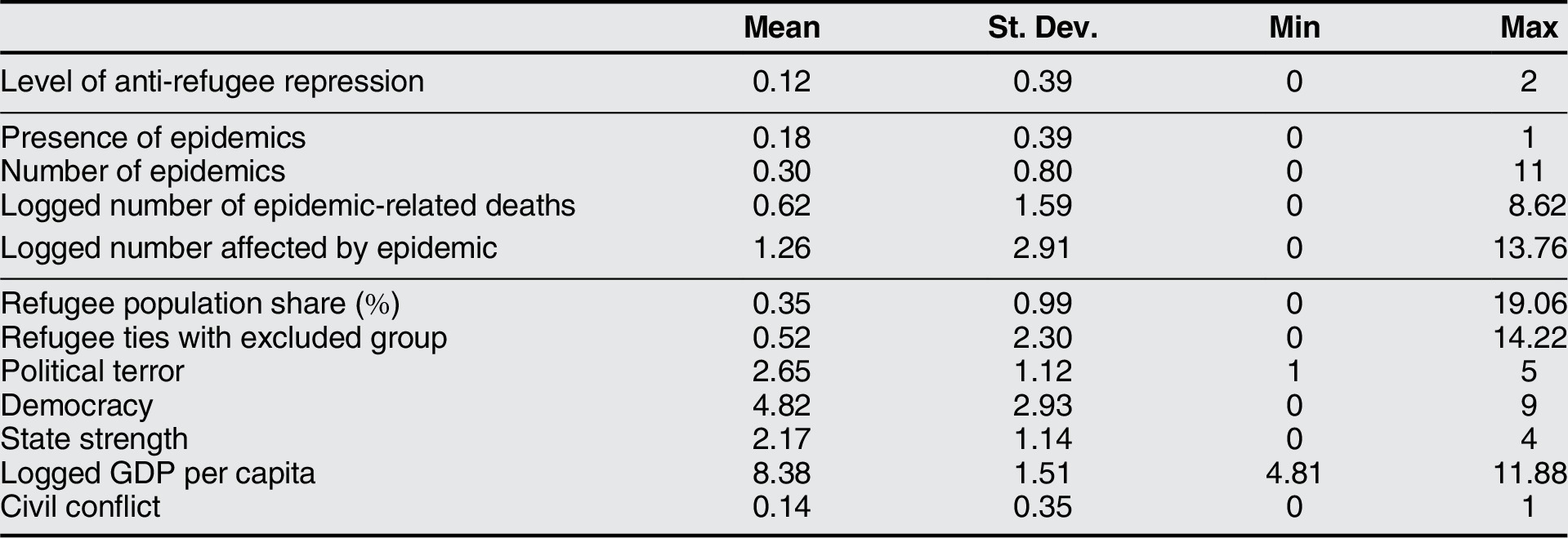
Results
To begin investigating our first hypothesis, we start with a simple cross-tabulation of epidemic outbreaks and government repression of refugees across our sample of country-years. Table 2 shows a significant increase in the likelihood of repression against refugees in years with epidemics. We observe some repression in 18% of country-years during which there is an epidemic, compared to just 7% of years in which there is no epidemic. Moreover, the likelihood of moderate to high levels of repression of refugees is three times higher in the presence of an epidemic than in their absence. This represents prima facie support for our first hypothesis.
Table 2 Probability of anti-refugee government repression by presence of epidemics

* Chi2(2) = 92.03, p < 0.01. N = 3640
We subsequently conduct multivariate analyses to examine whether these initial indications of a positive relationship between epidemic outbreaks and anti-refugee repression are upheld while controlling for potentially confounding factors. Given the ordinal nature of our dependent variable, we first estimate an ordered logistic regression model [OLR] with standard errors clustered by countries. In our second model, we then present an OLR including a lagged version of the dependent variable as an additional right-hand side variable. We do so in order to control for the temporal dependence between levels of government repression of refugees. These pooled models examine both variation within and across country panels. We also conduct a third model with a fixed effects (FE) specification. The advantage of this approach is that it provides a stricter test of our hypothesis by control for unit-level heterogeneity and focusing upon within-country variation.Footnote 34 Table 3 presents these three main models.
Table 3 Ordered logistic regression of government repression of refugees
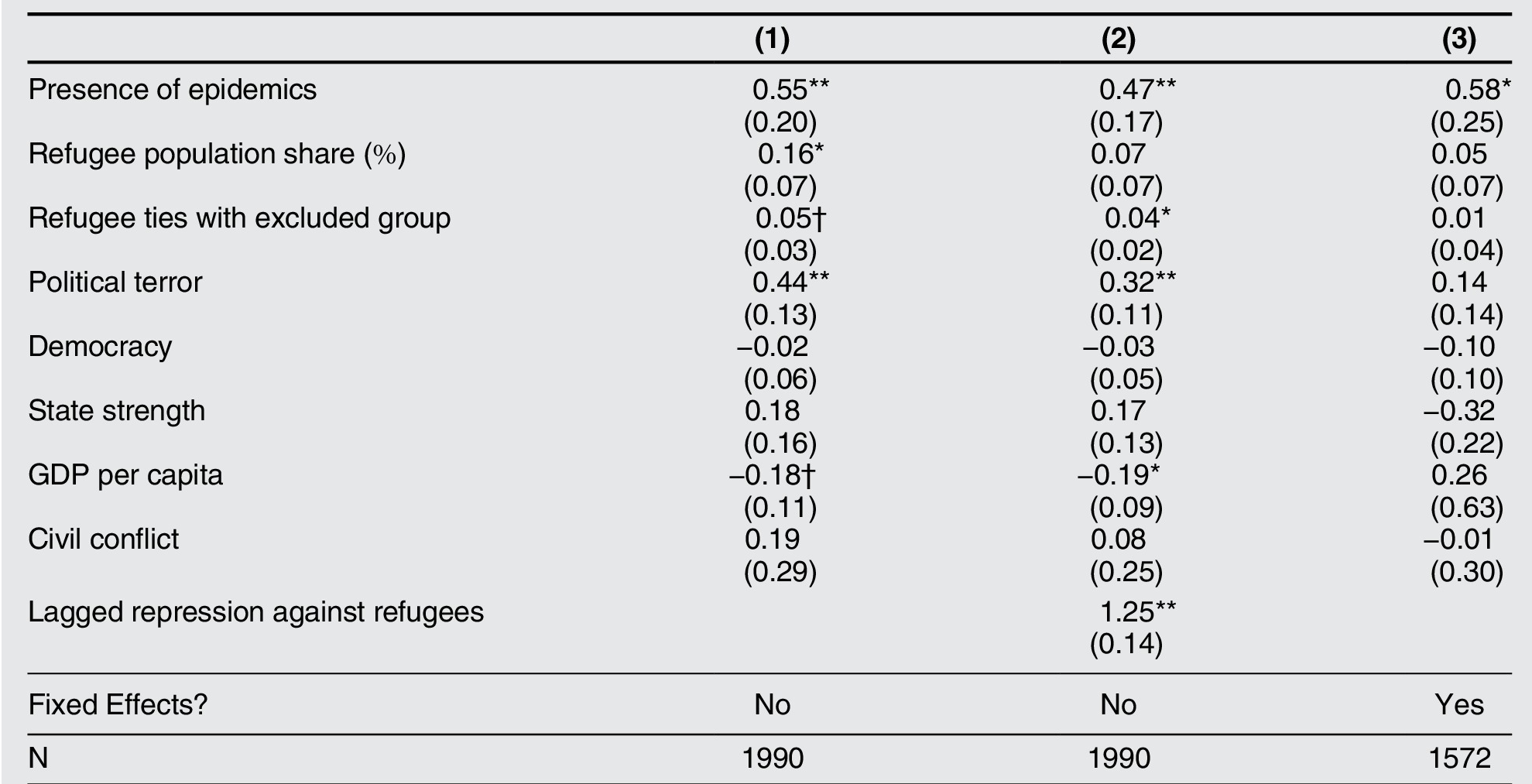
Note: † p < 0.1; * p < 0.05; ** p < 0.01 level. All tests are two-tailed.
Between our three main models, we find strong support for our first hypothesis. Across all models, the presence of epidemics returns a positive and statistically significant parameter estimate.Footnote 35 This effect also appears substantively meaningful. For example, in our OLR model, the occurrence of an epidemic in the previous year is associated with a 73% increase in the odds of a greater level of repression of refugees in the current year.
With respect to the control variables and the first two models, we find that political terror is the only other consistent statistically significant predictor of government violation of physical integrity rights of refugees. Government repression of refugees is more likely in countries with lower respect for physical integrity rights. In the first model, we also find that refugee population share is a significant predictor of elevated levels of repression against refugees. Two other variables in model 1, refugee ties with excluded group and GDP per capita, approach conventional standards of statistical significance. However, both of these variables are statistically significant in model 2. In model 2, the lagged version of the dependent variable is also a statistically significant predictor of elevated levels of repression against refugees in the present year. When we move to the FE specification (model 3), however, none of our control variables achieve statistical significance. This should be interpreted with caution due to the more limited power of these models given the focus upon within-panel variation.
We also run a battery of additional tests to determine the robustness of evidence in support of our first test hypotheses by replacing our main explanatory variable. We expand the window of time over which we consider the occurrence of epidemic outbreaks to cover the previous three years. We also consider the scale of epidemic outbreaks, which we operationalize in three ways. First, we include a count of the number of epidemic outbreaks experienced in the country in the previous year. The data for this variable ranges from 0 to 11 and we truncate it at five or more.Footnote 36 Second, we also include variables measuring the logged estimated number of deaths, and the logged estimated number affected in terms of requiring immediate assistance, by epidemic outbreaks in the country in the previous year. The underlying data for these variables range from 0 to 5,539 deaths and from 0 to 942,153 affected in a country-year.Footnote 37
As shown in the table 4, our finding holds in three of the four models (4, 5, and 7) with different operationalizations of the main explanatory variable. That is, the presence of epidemics in the previous three years, the count of the number of epidemics in the previous year, and the number of people affected by epidemics are all associated with increasing levels of government repression against refugees. The only exception here is observed in model 6 where the estimated number of deaths related to epidemics only approaches conventional standards of statistical significance (p = .07). One could anticipate that more deaths from epidemics would exacerbate the government’s use of repression against refugees. However, it might be that government opportunism actually gives them an incentive to target refugees at the first sign of a crisis emerging and, thus, not wait for casualties to accumulate. This post-hoc explanation would be consistent with the logic of opportunistic repression and our FE findings earlier.
Table 4 Robustness tests of anti-refugee government repression

Note: N = 1990; † p < 0.1; * p < 0.05; ** p < 0.01 level. All tests are two-tailed.
Having established consistent evidence in support of Hypothesis 1, we next test the empirical validity of Hypothesis 2, which suggests that the effect of epidemics on repression of refugees should increase as the size of refugee population increases. Table 5 presents supporting evidence for this expectation. Model 8 is our main model with the inclusion of an interaction between epidemics and the refugee population share.
Table 5 The effects of epidemics on the level of anti-refugee government conditional on refugee population size and regime type
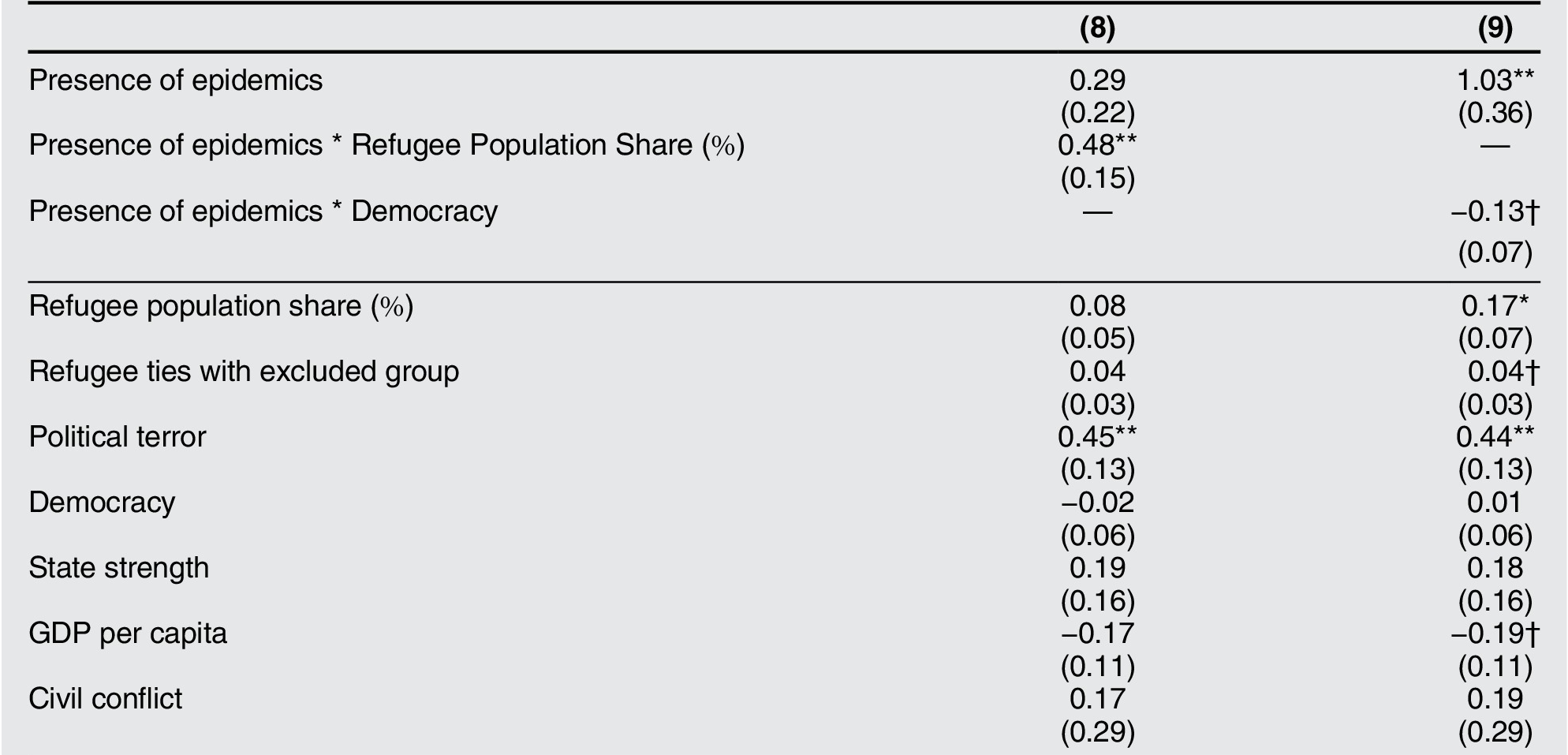
Note: N = 1990; † p < 0.1; * p < 0.05; ** p < 0.01 level. All tests are two-tailed
Because the coefficients of the interaction effect can be difficult to interpret directly, we illustrate the substantive effects from this model in figure 1. This figure shows the expected marginal effect (and the associated confidence intervals) on the probability of any level of government repression of refugees if an epidemic occurs, compared to when an epidemic does not occur, across the range of the variable capturing the refugee population as a share of the local host population. For example, for most countries that host a negligible refugee population, an epidemic is expected to increase the likelihood of repression by around 2%–5%. However, for countries hosting more sizeable populations of refugees such as Republic of Congo, Liberia, and Iran where refugees have on average in the past 10–20 years represented around 2% of the resident population, an epidemic is expected to increase the risk of repression of refugees by nearly 20%. Going further, countries such as Jordan where refugees in recent times makeup from 5% to 10% of the population, the risk of repression increases by around 50% to 80% if an epidemic occurs. Taken together, given the status of these and similar countries as refugee hosting countries, this reflects a considerable increase to the risk of government repression of refugees.

Figure 1 The marginal effect of epidemics on repression of refugees across refugee population share
Model 9 (table 5) provides results for our test of Hypothesis 3. Here we include an interaction term between epidemics and the measure of regime type. Although the parameter estimate on the interaction term is only approaching conventional levels of statistical significance, it is in the direction hypothesized, and it is still important to visualize the effects of epidemics across the range of autocracy-democracy (p = .08). Figure 2 presents this parameter estimate, again in terms of the marginal effect on repression if an epidemic occurs compared to when an epidemic does not occur. In line with our expectations, the relationship between the occurrence of epidemics and violence against refugees is present but only remains statistically significant in the range of autocratic government. In substantive terms, the expectation of government repression of refugees increases by just over 10% in closed autocracies and around 7% in electoral autocracies when an epidemic outbreak occurs, as compared to periods without epidemics. By contrast, the effect of epidemics on repression of refugees is not statistically significant across the range of the variable identifying forms of democratic government. As argued earlier, one likely reason for this is that while democratic governments may have incentives to try to reduce the numbers of refugees being hosted locally, they likely also have lower incentives (than autocracies) to specifically do so during crises. This is likely because they are better able to detect, report, and respond to epidemic outbreaks given their public health infrastructure, economic resources, and institutional capacity (Oppenheim et al. Reference Oppenheim, Gallivan, Madhav, Brown, Serhiyenko, Wolfe and Ayscue2019).
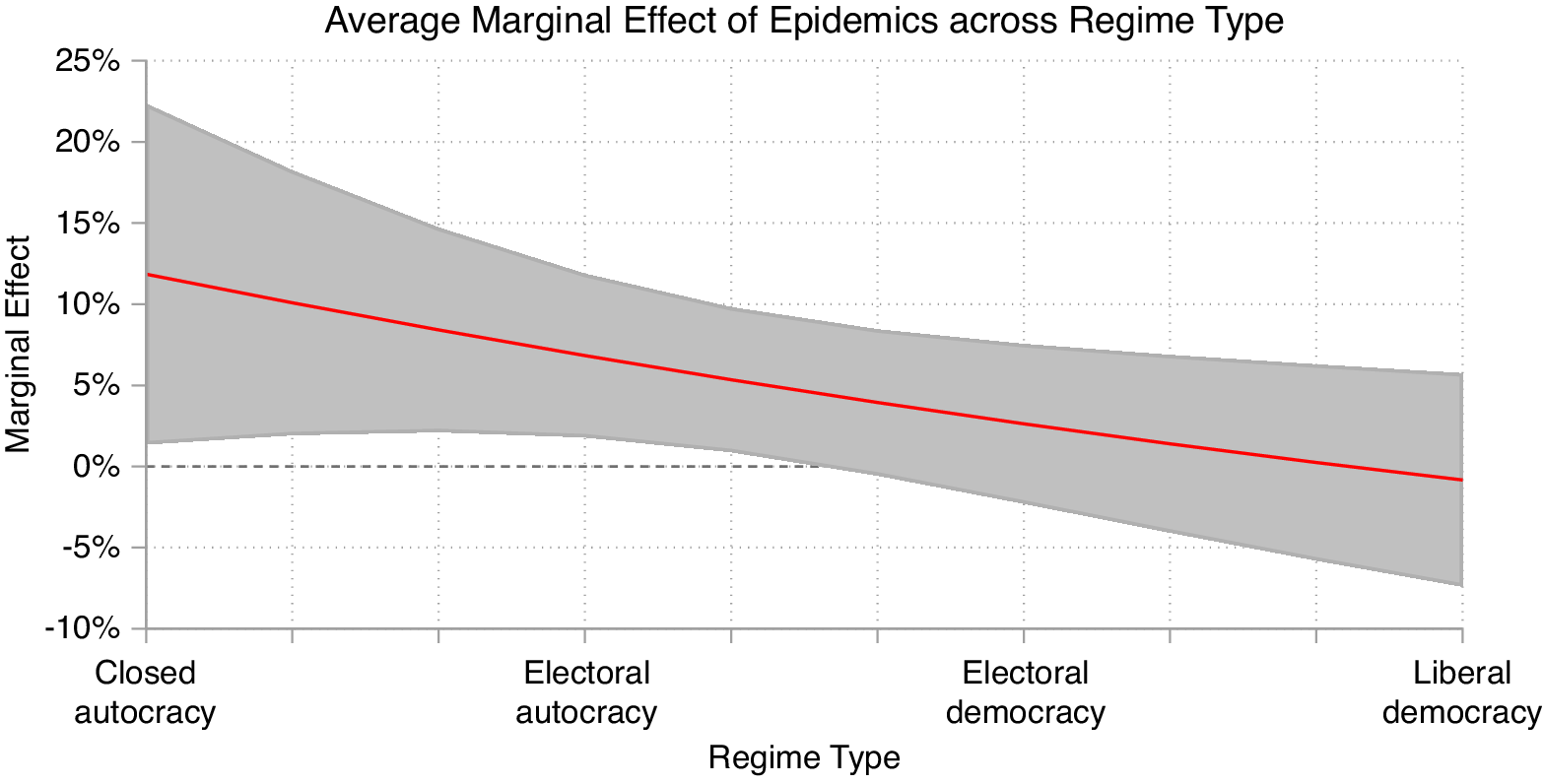
Figure 2 The marginal effect of epidemics on repression of refugees across regime type
Conclusion
Refugees are more commonly the targets of violence and repression than they are its perpetrators (Onoma Reference Onoma2013). Refugee journeys often begin out of a desire to escape the dangers of violence. All too often, these journeys end with subsequent forms of victimization (Fisk Reference Fisk2018, Savun and Gineste Reference Savun and Gineste2019). In this paper, we demonstrate one potential source of this subsequent victimization: that governments appear to increase their violent targeting of refugee populations as the number of epidemics experienced locally increases. This effect, which we attribute to scapegoating (see also Savun and Gineste Reference Savun and Gineste2019) and opportunistic repression (Grasse et al. Reference Grasse, Matfess and Curtice2020), appears especially strong during epidemic outbreaks, when the country is host to larger proportions of refugees, and when the host government is autocratic.
These secondary effects are especially important for our understanding of the burdens faced by refugee host countries and the difficult situations that refugees face in these contexts. In addition to identifying a general relationship between the occurrence of epidemics and government repression of refugee populations, our analyses suggest this effect is even greater in contexts in which the government is hosting larger populations of refugees (relative to citizen populations). In other words, governmental anti-refugee violence is especially likely in contexts in which tensions between host and refugee populations are already likely to be heightened or in situations in which governments have a pre-existing agenda to try to coerce refugee populations to leave the country and deter potential future refugees from arriving. In such circumstances, it appears that governments can more easily scapegoat and opportunistically repress the outgroup without fear of backlash from the native citizenry. This makes sense on a practical level and also means that the UNHCR and relief agencies have yet another reason to dedicate their scarce resources to those contexts in which local hosts are heavily burdened.
This task is arguably made more difficult, however, by the fact that these effects are also greatest in the population of autocratic states—environments in which non-governmental actors often have many more obstacles to navigate in carrying out their work. Given the current trend towards nationalist and populist regimes (Pevehouse Reference Pevehouse2020) and the potential for democratic backsliding during the ongoing COVID-19 pandemic (Greitens Reference Greitens2020; Stasavage Reference Stasavage2020), we should pay close attention to the potential for this identified relationship to be exacerbated as we move forward.
Our theory and empirical analyses largely treat refugee populations as if they are homogenous. Of course, it may be that not all refugee populations are equally likely to be targeted for repression by host governments. For example, following our logic, one might anticipate that refugees sharing ethnic ties with discriminated groups in host states are more likely to face repression than are those with no ethnic ties. Our models show that this is usually the case. It is plausible that this effect is further amplified during epidemics. While this is a direct implication of our argument, we do not have appropriate data to test this conditional effect. The POSVAR dataset does not allow us to distinguish whether refugees that are the targets of government repression share ethnicity with politically excluded groups in host states.
While the ongoing COVID-19 epidemic is not captured in our analyses, our findings do suggest that we should be vigilant for signs of governments targeting their wrath at vulnerable refugee populations when they look to shift focus away from their own poor handling of the situation. Vigilance is especially warranted, it would seem, as a means of guarding against informal violations of norms of and commitments to non-refoulement. In terms of explaining the effect of epidemic outbreak on targeting of violence against refugees, we do not trace blame attribution in this study. Thus, we cannot observe directly whether governments are likely to take the heat for responding slowly to crises and, thus, have an incentive to try to shift this blame on to more vulnerable populations. Nor do we demonstrate whether governments enjoy any benefits from this shift of blame and subsequent targeting of the vulnerable populations. We do hope, though, that our initial evidence spurs further investigation into these and related dynamics.
Acknowledgements
The authors are supported by the Army Research Office under Grant Number W911NF-17-1-0030. The views and conclusions contained in this document are those of the authors and should not be interpreted as representing the official policies, either expressed or implied, of the Army Research Office or the U.S. Government




